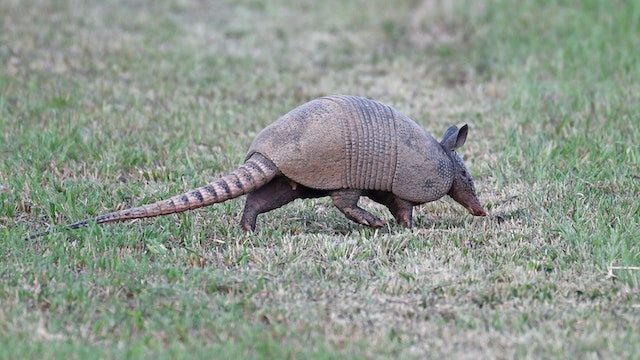
How strong is armadillo armor? Extremely strong, but not strong enough to stop a bullet.
Armadillos are native to the Americas and their name means “little armored ones” in Spanish. They have short legs and very long claws that they use to dig up insects to eat or to burrow. They can run extremely quickly, despite their short legs. They have poor eyesight but a very strong sense of smell. They have long, sticky tongues to pull ants and termites out of their tunnels. They sleep for up to 16 hours a day. There are 21 different species of armadillo and they range in size from the pink fairy armadillo, which is 85 grams and 15 cm long to the giant armadillo, which is 54 kg and 150 cm long. There used to be an armadillo called glyptodont that weighed about 2,000 kg, but they became extinct about 11,000 years ago.
Armadillos are famous for their armor. It is made up of plates of dermal bone, which is a type of bone that is grown under the skin and is different to regular bone. Regular bone begins as cartilage that becomes bone. Dermal bone forms in the skin from a matrix of calcium phosphate and salts. Dermal bones are usually thick and platelike. The shell of a tortoise is made of dermal bone. The dermal bone plates are usually hexagonal or triangular. The bony plates are called osteoderms and they are attached to the armadillo because they grow out of the skin.
The dermal bone plates are covered in small overlapping scales that are called scutes. These are bony scales, such as on the skin of crocodiles, and they are made of keratin. Keratin is the protein that makes hair, nails, and horns. The scales are attached to each other by very strong collagen fibrils called Sharpey’s fibers.
The armor is divided into bands that are attached by flexible skin, allowing the armadillo to move. They have armor on their heads, across their shoulders, down their backs, and on their tails. The armor is very hard, but it is also flexible. It is similar to the shell of a tortoise, but the tortoise shell isn’t flexible and so tortoises cannot run fast. Because the armadillo shell is broken up into bands, the armadillo can run at speeds up to 48 km/h. It can absorb shocks and protect the armadillo from falls. The entire armored shell usually weighs about 15% of the armadillo’s weight. The armor seems like a wonderful advantage, but the shell makes the armadillo’s thorax rigid, which means they have to take shallow, rapid breaths in order to get enough oxygen.
The armor is very tough and is used as protection against predators. The underside of the armadillo doesn’t have any armor, so the armadillo tries to keep this part down when attacked. If threatened, they will very quickly dig a hole large enough to squeeze their soft underbelly into, only leaving their armor protruding from the ground. Only armadillos in the tolypeutinae family are able to roll themselves into a ball when threatened. Other armadillos rely on their armor to ward off attacks and then run away as soon as they can. Often, they run into thorny shrubs, knowing that most animals can’t follow them. The armor is also used to keep the armadillos warm or cool, and to conserve water. It also protects them from stinging and biting insects.
So, how strong is armadillo armor? Tests have shown that the armor of an armadillo has a tensile strength of 20 MPa. 1 MPa is equal to 10 kgs of force per square centimeter. That means, 20 MPs is 200 kgs of force per square centimeter. This is where the claim that an armadillo shell could support the weight of a car comes from. The shell probably could, but the armadillo itself wouldn’t be able to. There are also stories of armadillo shells deflecting bullets that have then ricocheted back to injure the owner of the gun. However, if these stories are true, they are extremely rare and the ricochet was probably caused because of the angle that the bullet hit the shell. Human bone can make a bullet ricochet if the angle is right. Look at the magic bullet in the JFK assassination if you want to see that. If a bullet is fired directly at an armadillo shell, even the lowest caliber bullet will penetrate the shell. A bullet has more energy than any natural animal armor can deflect. And this is what I learned today.
Sources
https://h-o-m-e.org/are-armadillos-bulletproof/
https://www.zoology.ubc.ca/~millen/oldvertebrate/skeleton.htm
https://www.nationalgeographic.com/animals/article/animals-armor-bioinspiration
https://www.pawsgeek.com/how-strong-is-an-armadillo-shell
https://pubmed.ncbi.nlm.nih.gov/21565719/
https://www.nationalgeographic.com/animals/mammals/facts/armadillos
https://en.wikipedia.org/wiki/Glyptodont
https://en.wikipedia.org/wiki/Dermal_bone
https://en.wikipedia.org/wiki/Scute
https://en.wikipedia.org/wiki/Armadillo
